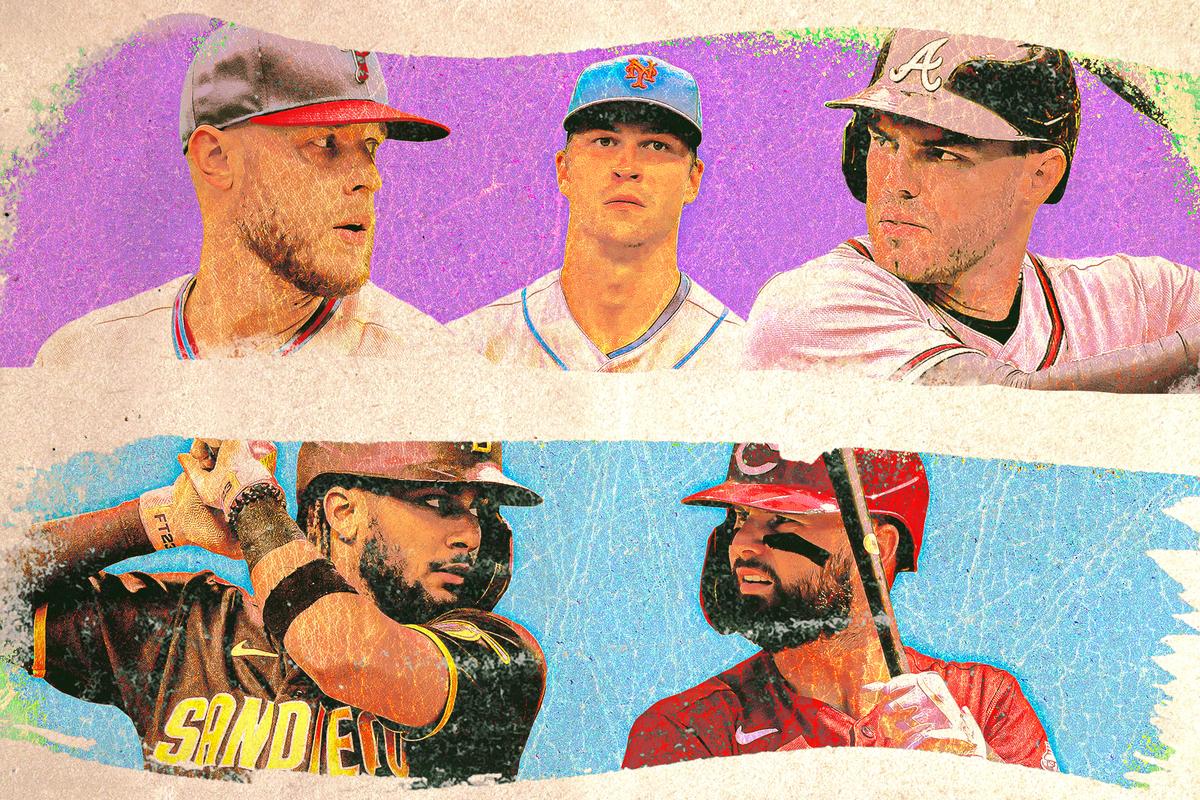
From the Saints’ curious quarterback pairing to the Titans’ superstar wide-receiver combo, The Ringer is highlighting the most important, interesting, and, in some cases, baffling NFL duos for the 2021 season. First up: Jon Gruden and Mike Mayock.
The late Anthony Bourdain had a philosophy about restaurant menus: Shorter is better. Limited offerings suggest refined expertise, while a kitchen attempting sushi and bolognese is likely to fail at both.
It’s good advice for diners, but also for chefs and owners in a volatile business with thin margins, where hubris often goes hand in hand with failure. The average restaurant life span is less than five years, or, to put it differently, less than half the length of Jon Gruden’s contract with the Raiders.
Gruden is three years into his 10-year head coaching deal in Las Vegas, the longest and richest contract on record for an NFL head coach. He has been partnered with his handpicked general manager, Mike Mayock, for the last two. Gruden designs the offense, calls the plays, and is the most recognizable figure within the organization. However, Las Vegas is 19-29 under his watch and has yet to make the playoffs. If the Gruden-Mayock Raiders have an identity, it is as a good offensive team that has gotten better on that side of the ball each year the coaching staff has been in place. That progress seems to be blunted annually, though, by Las Vegas’s other calling card: haphazard personnel decisions that lack any obvious set of uniting principles. Mayock’s record as a general manager has been spotty, marked by baffling draft choices and an overreliance on veteran players, but Gruden’s influence in the organization makes both men culpable for the state of the team’s roster. Gruden has a hand in everything, which seems to be hindering the things he actually does well. If you’re still with me in this increasingly distant metaphor, he is attempting both sushi and bolognese and appears undeterred by any suggestion that his plan is not succeeding.
“You got to go all out,” Gruden said at the start of training camp. “I’m not going to get too deep and philosophical after the first day of pads, but we all got to be on the same page. We’ve got a great group of guys. The energy level is extreme, and we’ve got good veteran leadership on this team. I like the culture here better than any of the teams I’ve had in a long time or been a part of.”
If there was a unifying theme of Las Vegas’s offseason, it was improving the defense. Five of seven draft picks—including second-round safety Tre’von Moehrig, third-round defensive end Malcolm Koonce, and third-round linebacker Divine Deablo—were spent on defensive players. The Raiders’ biggest free-agent signing was edge rusher Yannick Ngakoue; he’ll be reunited with the team’s new defensive coordinator Gus Bradley, who was head coach in Jacksonville in 2016 when the Jaguars drafted Ngakoue. The Raiders also re-signed linebacker Nicholas Morrow and defensive lineman Johnathan Hankins and added defensive linemen Quinton Jefferson and Solomon Thomas, cornerbacks Casey Hayward and Blidi Wreh-Wilson, and safety Karl Joseph.
Collectively, these players should help. It would be hard for the Raiders to be worse defensively in 2021 than they were in 2020, when they ranked 30th in points allowed, 25th in yards, 29th in sacks, and tied for 23rd in interceptions. Defensive coordinator Paul Guenther was fired midseason.
The trouble, though, is that these potential defensive improvements came at the same time as other moves that threatened to diminish the Raiders’ strengths on offense, chiefly the team’s strange dismantling of the offensive line while investing heavily in running backs.
Gruden and Mayock have a spotty draft record, particularly when it comes to top picks, but two highlights have been tackle Kolton Miller, a 2018 first-rounder, and running back Josh Jacobs, a 2019 first-rounder. I could use the Jacobs selection as an opportunity to venture down the well-worn pathways of the running-back value debate, were it not for the fact that I would rather eat a Carolina Reaper pepper while standing in line at the DMV with a pebble in my shoe. Instead, I will simply state that while conventional wisdom discourages drafting running backs in the first round, there are nuances and exceptions to this theory, and that first-round running backs can add meaningful value to their teams, particularly while on their inexpensive rookie contracts. Some of those nuances and exceptions could apply to a player like Jacobs, who has produced back-to-back 1,000-plus yard seasons. They do not apply, however, to the practice of spending a first-round pick on a productive running back with an inexpensive rookie contract and then spending $11 million guaranteed on another player at the position, which is what Las Vegas did this offseason in signing Kenyan Drake.
“A lot of people say, ‘Why Kenyan Drake?’ Well, Doug Martin had 190 touches three years ago when [Marshawn] Lynch went down,” Gruden told the Raiders website this offseason. “DeAndre Washington had 144 touches when Jacobs went down two years ago. And this past year, Josh went down and Devontae Booker got 110 touches. So we’re going to try to circulate the touches Kenyan Drake’s way. He’s a guy that’s made big plays.”
Even if Gruden’s logic in spending $11 million in guaranteed salary to a redundant veteran is sound, it’s still hard to fathom why he and Mayock proceeded to dismantle what had been a solid offensive line for no discernible reason. The Raiders were 10th in the NFL with 28 sacks allowed and 18th in Football Outsiders’ adjusted line yards last season—nothing spectacular, but it was dependable with no obvious weak links. Then, Gruden and Mayock traded away three starters—center Rodney Hudson to the Cardinals, right guard Gabe Jackson to the Seahawks, and right tackle Trent Brown (who made $36.8 million in 16 starts over two years playing for the Raiders) to New England, where he agreed to a sizable pay cut.
The Raiders’ unofficial depth chart lists the 2021 line, from left to right, as Miller, guard Richie Incognito, center Andre James, guard Denzelle Good, and 2021 first-round draft pick right tackle Alex Leatherwood, meaning that the middle and right side of the line is made up of players who have never been consistent NFL starters.
Such inexperience threatens the Raiders where they’re strongest. The haphazard decision-making and mixed results in Las Vegas are more notable and frustrating given that Gruden has fielded a good and improving offense each year he’s coached the team. The Raiders were 23rd in total yards in 2018, 11th in 2019, and eighth last season, when they were also 13th in EPA per play, eighth in yards per play, 10th in points, 14th in Football Outsiders’ offensive DVOA, and ninth in passing DVOA. Gruden is not slapping on a visor each Sunday and running Spider 2 Y Banana until he’s ready to call it a day. This is a genuinely modern, creative, and dynamic offense run effectively by quarterback Derek Carr, who, entering his eighth NFL season, has steadily improved under Gruden.
Carr has had three 4,000-plus yard passing seasons under Gruden, with an improved touchdown-to-interception ratio, yards per game, passer rating, and QBR each year. Last season, he improved significantly in his deep passing, generating a career-best 97.8 Pro Football Focus grade on deep balls. Carr and Gruden have done this without a true no. 1 receiver, and Gruden has done so with a quarterback generally regarded as good, not great. Those facts add up to an impressive coaching, scheme-designing, and play-calling job done by Gruden, but they haven’t yet added up to on-field success.
Some of the Raiders’ offseason moves—trading the majority of its starting offensive line, in particular—seem like unforced errors, but the team would have more opportunities to help its offense in free agency if it wasn’t making up for its poor draft record. Miller and Jacobs are the hits in Gruden’s tenure, but 2018 second-round pick P.J. Hall, a defensive tackle, was waived after two seasons; safety Johnathan Abram, a first-rounder from 2019, struggled last season; and receiver/running back Lynn Bowden Jr., a third-round selection in 2020, was traded to the Dolphins months later before the start of last season. Clelin Ferrell and Damon Arnette, first-round picks from 2019 and 2020, respectively, are both running with the second team during training camp.
“[Arnette] was an incomplete performer for us last year, but he’s as good a corner as we have talent-wise on this team,” Gruden said. “We think he and Trayvon Mullen and Casey Hayward, some of the other people that are in the mix now, give us depth, competition, and some interesting matchups. So, I’m fired up about the secondary.”
The pattern of papering over draft misses with veteran players is discouragingly familiar for Raiders fans, but it’s especially troubling at the start of the season in which Las Vegas—Gruden and Mayock, but mostly Gruden—will have to make a major decision about Carr’s future with the team. Carr is set to hit free agency in 2023, so the Raiders will need to make a decision about whether they want to extend his contract by next offseason. This season is especially important since it’s the one during which the Raiders will choose to either continue building around Carr or start looking for a new quarterback.
The Raiders’ poor defensive units have hurt their performances over the last three seasons, but now it seems as though the need for defensive reinforcements is chipping away at the foundation of the team’s strength. The benefits of those defensive changes, while warranted, remain to be seen. Bradley has been the architect of successful units, but the Seattle-style defense he runs is considered increasingly outdated relative to the Vic Fangio–derived schemes spreading across the league. That leaves an organization in search of results and an identity with an aging roster that is seemingly uprooted each offseason.
Gruden is attempting sushi and bolognese, working the grill while he’s at it, and doing it all like a contestant on Chopped—with a rotating and inapt list of ingredients. Little is clear about the Raiders’ future except for one thing: It will revolve around Gruden doing what he does best—scheming an offense—but probably also quite a bit more.

